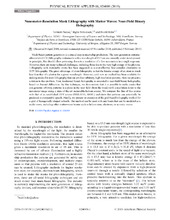Nanometer-Resolution Mask Lithography with Matter Waves: Near-Field Binary Holography
Peer reviewed, Journal article
Published version

Åpne
Permanent lenke
https://hdl.handle.net/1956/22337Utgivelsesdato
2019Metadata
Vis full innførselSamlinger
Originalversjon
https://doi.org/10.1103/physrevapplied.11.024009Sammendrag
Mask-based pattern generation is a crucial step in microchip production. The next-generation extreme-ultraviolet- (EUV) lithography instruments with a wavelength of 13.5 nm are currently under development. In principle, this should allow patterning down to a resolution of a few nanometers in a single exposure. However, there are many technical challenges, including those due to the very high energy of the photons. Lithography with metastable atoms has been suggested as a cost-effective, less-complex alternative to EUV lithography. The great advantage of atom lithography is that the kinetic energy of an atom is much less than that of a photon for a given wavelength. However, until now no method has been available for making masks for atom lithography that can produce arbitrary, high-resolution patterns. Here we present a solution to this problem. First, traditional binary holography is extended to near-field binary holography, based on Fresnel diffraction. By this technique, we demonstrate that it is possible to make masks that can generate arbitrary patterns in a plane in the near field (from the mask) with a resolution down to the nanometer range using a state-of-the-art metastable-helium source. We compare the flux of this source with that of an established EUV source (NXE:3100, ASML) and show that patterns can potentially be produced at comparable speeds. Finally, we present an extension of the grid-based holography method for a grid of hexagonally shaped subcells. Our method can be used with any beam that can be modeled as a scalar wave, including other matter-wave beams such as helium ions, electrons, or acoustic waves.